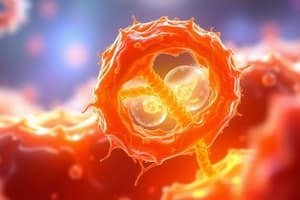Podcast
Questions and Answers
What does the 'one gene-one polypeptide' hypothesis state?
What does the 'one gene-one polypeptide' hypothesis state?
It states that the function of an individual gene is to dictate the production of a specific enzyme.
How are amino acids coded?
How are amino acids coded?
They are represented by each codon; 61 of 64 triplets code for amino acids.
What is RNA?
What is RNA?
Nucleic acid containing the sugar ribose.
What is transcription?
What is transcription?
What is translation?
What is translation?
What is a codon?
What is a codon?
How did Beadle and Tatum's research lead to the 'one gene-one polypeptide' hypothesis?
How did Beadle and Tatum's research lead to the 'one gene-one polypeptide' hypothesis?
Which molecule completes the flow of information from DNA to protein?
Which molecule completes the flow of information from DNA to protein?
Which amino acid is coded for by the RNA sequence CUA?
Which amino acid is coded for by the RNA sequence CUA?
List two ways RNA is different from DNA.
List two ways RNA is different from DNA.
Flashcards are hidden until you start studying
Study Notes
One Gene-One Polypeptide Hypothesis
- Proposes that individual genes direct the synthesis of specific enzymes, emphasizing the relationship between genes and metabolic functions.
Coding for Amino Acids
- Amino acids are encoded by codons; 61 out of 64 possible codons represent different amino acids.
RNA Overview
- Ribonucleic acid (RNA) is a nucleic acid featuring ribose sugar, playing crucial roles in genetic coding and expression.
Transcription Process
- In transcription, a DNA template is transformed into a single-stranded RNA molecule, initiating gene expression.
Translation Process
- Translation involves decoding RNA sequences to form specific chains of amino acids, resulting in protein synthesis.
Codon Definition
- A codon is a three-base sequence in RNA that corresponds to a specific amino acid in the growing protein chain.
Beadle and Tatum's Research
- Their studies with mutant strains of mold revealed each strain lacked a specific enzyme, leading to the conclusion that each gene corresponds to a specific enzymatic function.
Completion of Information Flow
- RNA molecules act as intermediates, completing the genetic flow of information from DNA through to protein synthesis.
Coded Amino Acid
- The RNA sequence CUA encodes the amino acid leucine (Leu).
Differences Between RNA and DNA
- RNA contains ribose sugar, whereas DNA contains deoxyribose.
- RNA includes uracil as a nitrogenous base in place of thymine, which is found in DNA.
Studying That Suits You
Use AI to generate personalized quizzes and flashcards to suit your learning preferences.




